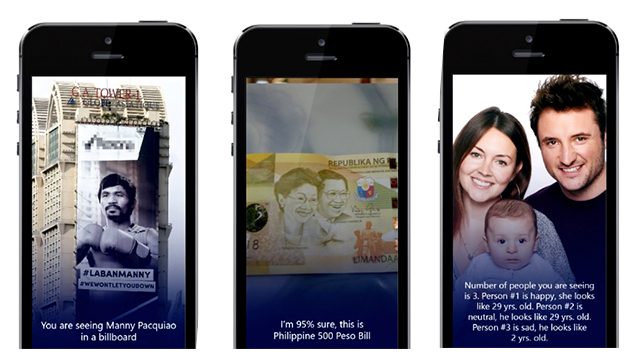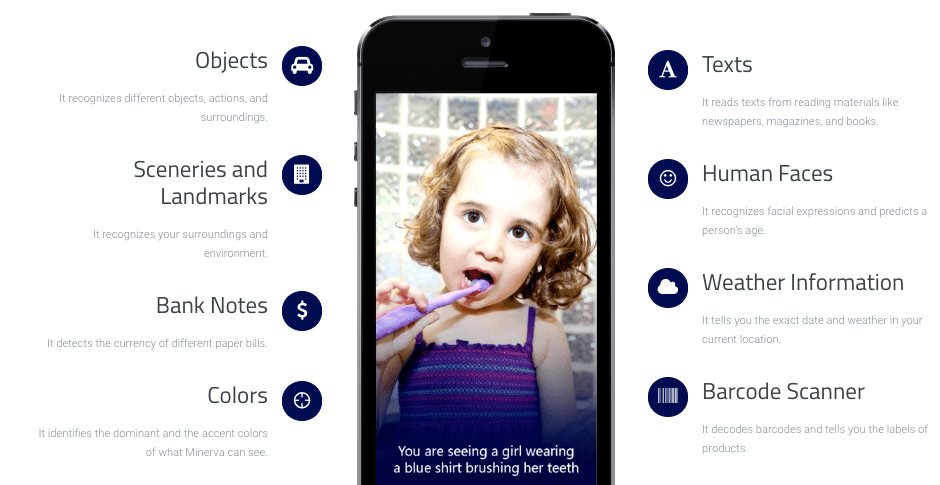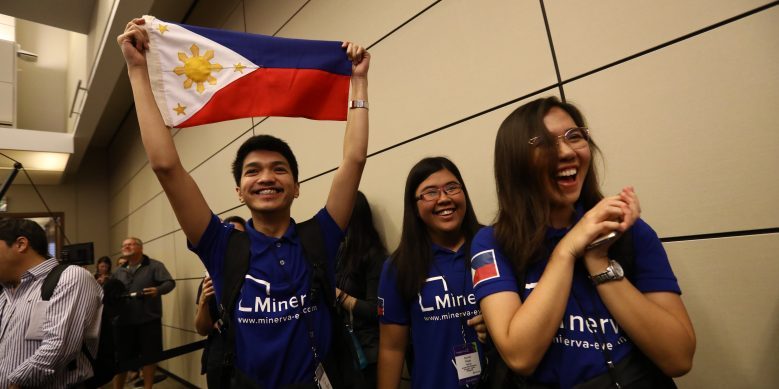SUMMARY
This is AI generated summarization, which may have errors. For context, always refer to the full article.

MANILA, Philippines – In late July, Microsoft’s annual Imagine Cup, dubbed the “Olympics of Technology,” rounded up 54 finalists – student teams from 39 countries – to prove that they’re worthy of the $100,000-grand prize and mentorship from Microsoft CEO Satya Nadella.
The Philippines’ bet, Lyceum of the Philippines’ Team Opticode, finished in the top 10 of the global competition, joining the Nepal team as the only ones from the ASEAN to finish that high. In the global round, Opticode also bested Indonesia’s Team CIMOL and Singapore’s Team HeartSound, which finished as the champion and the 1st runner-up respectively in the Southeast Asian regionals.
Opticode’s app? Minerva, an app meant to transform smartphones into a useful tool for the visually-impaired, that will help them interact with their surroundings. Opticode, comprised of Christian Lou Cepe, Jasmine Pearl Raymundo, and Rochel Reyes, wanted to imbue smartphones with the power to act as eyes for its user – and one that was easy to use.
How does it work?

Using a smartphone’s camera, the app identifies objects in the real world, then describes it aloud for the user, through the phone’s speakers. The user simply has to point the camera toward the object – similar to taking a photo of it.
The app comes with different modes, easily switched by gesture-based interactions like taps and swipes. Upon first starting the app, Minerva asks aloud for the user to select between its two primary modes: “Sighted” and “Blind” mode.
Geared towards those who have not completely lost their vision and the color blind, “Sighted” mode comes with two secondary modes: “Image Search” and “Color” mode. In the former, Minerva presents users with a list of online references about the object in the photo taken by the user. In the latter, as the name would suggest, Minerva helps users recognize and describe colors to users.
“Blind” mode, on the other hand, comes with several modes. One is “Describe” mode, the app’s most basic function of recognizing and describing objects. “Human Faces” mode recognizes and describes gender, emotion (through facial expressions), and a person’s probable age. “Common Color” mode is the equivalent of “Color” mode for this setting; except that it has deeper recognition, picking up on dominant and accent colors.
“Reading” mode reads text from reading materials. There is also a “Weather” mode which reads exact weather conditions with regards to the user’s location.
Minerva’s voice also describes everything going on in the app, serving as a guide to users on whether they should be tapping or swiping the screen.
Text-to-speech, machine learning, and artificial intelligence technologies running on Microsoft’s cloud-computing platform Azure all help power Minerva. Being cloud-powered, Minerva has to be connected to the internet to work.
Minerva also comes in 25 languages like English, Chinese, and Korean to name a few.
Future optimizations
Before coming up with the app, the students of Team Opticode were already involved with organizations that helped those with visual impairment. They said that the stories of the people they interacted with touched and inspired them to create Minerva. They hope to help the hundreds of million of people that’s afflicted with some form of visual impairment, ranging from those who have difficulty seeing to those who are completely sightless.
The team states that according to figures by the World Health Organization in 2015, about 314 million people belong to this disability category.
Opticode says they are currently working with the same organizations for actual tests which have made them want to pursue adding voice command support to make the app even more accessible. Besides this, they are working on adding features they promised in their competition pitches to the app including the ability to make phone calls and send SMS messages with Minerva.
Essentially, Minerva is shaping up to become something that makes smartphones a whole lot more useful – and maybe essential – to the visually-impaired.
Minerva is still in-development, and is coming soon to Android, with other versions hopefully to follow, said Opticode.
Follow Opticode on Facebook here. Visit the Minerva website here.
Microsoft Imagine Cup 2017 winners

Opticode’s finish was lauded by Microsoft Philippines managing director Bertrand Launay in a press statement. Launay said: “This is a most impressive accomplishment for Team Opticode. The Imagine Cup is the world’s most prestigious student tech competition and we’re extremely proud of the team for all they’ve accomplished. A top 10 finish among 54 other teams from 39 countries in the World Finals shows that the Philippines can compete with the best in the world.”
This year, however, the best in the world came from Czech Republic, whose Team X.GLU came in first place, with an app designed to help people with diabetes cope with the symptoms.
Second place went to Team Oculogx of the United States, which fused Microsoft’s mixed reality headset HoloLens with Azure to build an app that makes it easier to find items in large warehouses. Argentina’s Team Nash took third place with RESCUE, which uses drones to help rescuers respond faster during natural disasters.
Fourth was Canada’s Team Neuro Gate, which uses data collected from Microsoft’s motion-sensing apparatus, Kinect, and machine learning to detect degenerative brain diseases by analyzing gait pattern. – Rappler.com
The Social Good Summit 2017 in the Philippines will challenge us to examine the purpose of innovation and ask the critical questions: Where are we? Where do we want to go? How do we get there?
The event is happening on Saturday, September 16. For interested participants, see more details here.
Add a comment
How does this make you feel?
There are no comments yet. Add your comment to start the conversation.